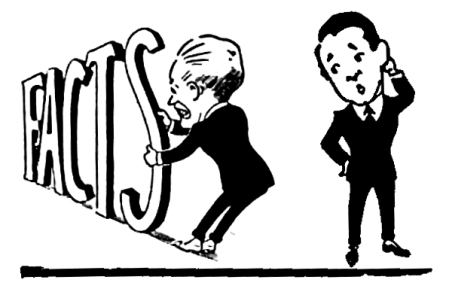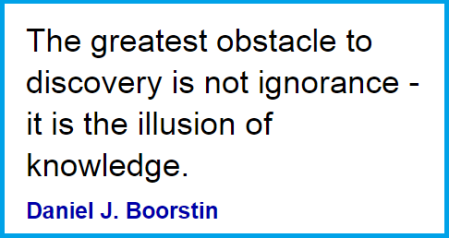In March I had a conversation with an insightful colleague, Amy Boyle, an educator at the Guggenheim Museum. Amy suggested that open-ended interpretation might be problematic in a climate in which political discourse disregards facts, and candidates and supporters make up their own truths. I’m not sure I’ve captured the challenges and opportunities offered by this idea, but I am convinced that museums have a role to play in helping people better understand facts and weigh opinions accordingly.
Museum educators have long struggled with the tension between teaching facts and curatorial analyses, and opening the door to personal interpretations and meaning-making. Do we lecture, or do we pose questions and follow the visitors’ lead? During this election season, the tension between sharing information and encouraging individuals to create their own interpretations has taken on new importance.
All sorts of lies are being bandied about, and claimed as truth. Just yesterday Donald Trump’s son claimed that a protester was attempting to assassinate his father, despite the fact that an investigation had already shown that this was not the case. These lies are effective propaganda only because people can’t be bothered to look further than their social media feeds for information, and do not take the time to investigate the source of various claims. (For more on this, see this episode of This American Life, and this New York Times op-ed piece.)
A decade ago Cheryl Mezaros argued that the open-ended, visitor-centric interpretive approach in museums can lead to inaccurate interpretations of objects, or what she calls “the ‘whatever’ interpretation.” Mezaros questions individual interpretation as a goal of museums and museum education. Do we care when these interpretations are entirely misguided? Shouldn’t museums, and museum educators, communicate the hard-won knowledge and thoughtful interpretations rooted in years of research?
Does current museum education practice contribute to a disregard for facts and expertise? As the relationship between facts, interpretation, and political will grows more complicated, museum staff might want to think carefully about how we foster respect for facts, as well as for informed interpretation and opinion. But what does it look like to cultivate respect for facts, and critical thinking habits that examines how we know what we know?
In a 1996 article, Zahava Doering and Andrew Pekarik propose that all visitors enter the museum with prior knowledge and an individual perspective. They argue that the ideal outcome of a museum visit is an active and engaged struggle between curatorial content and visitor perspective visitor interpretation. They ask:
Would you prefer education to mean that the visitor accepts everything that your museum says and gives it the same weight and emphasis that the museum does? Or would you prefer that visitors become engaged with the presentation, question it, and struggle with it intellectually and emotionally?
Given that each visitor arrives burdened or favored with prior knowledge, Doering and Pekarik suggest that museums should be places in which visitors take in a museum’s ideas, struggle with them, and emerge from that struggle with something more or different than either the museum’s presentation or the visitor’s prior knowledge.
Unfortunately, all too often the viewer dismisses rather than struggling. In a 2007 article in the Journal of Museum Education, Mark Felton and Deanna Kuhn, professors of education who specialize in critical thinking, describe a visitor at the American Museum of Natural History:
On a recent trip to a natural history museum, we witnessed a visitor roll her eyes at a display on evolution and groan to a friend, ‘Oh great, even the Museum of Natural History is caving in to the Religious Right. Now they’re calling evolution a theory‘ Shaking her head dismissively, she passed over the fossil evidence and moved on to another display…. The display she dismissed was designed to highlight for visitors the assertions, bodies of evidence, and arguments that constitute evolutionary theory, leaving them with an enriched understanding of the theory and its basis. But the effort did not succeed with this visitor. Because she was already certain that her knowledge was correct, she saw no purpose in asking herself, “How do I know?
Felton and Kuhn proceed to suggest how museums might teach better critical thinking skills:
[M]useum educators must engage visitors in ways that will promote the active evaluation of prior knowledge, prompting them to consider not only what they already know, but also how they know it, which brings us to the heart of critical thinking. By getting visitors to contemplate the question “How do I know?” museum educators are more likely to lead them to examine their understanding, revise their misconceptions, and build new knowledge on a stronger and more elaborate base of prior knowledge….
Putting together these two ideas – Doering and Pekarik’s perspective on visitors’ prior knowledge, and how this impacts perception of an exhibit, and Felton and Kuhn’s understanding of critical thinking, and what it takes to really think critically – might help museum educators plan for helping visitors think about how we know something is a fact, the difference between a fact and an interpretation, and what knowledge we need to assess or interpret a situation.
In a recent episode of This American Life, Ira Glass shares a recorded conversation with his Uncle Lenny. Lenny makes a series of claims about Obama that are demonstrably false – “He’s played more rounds of golf than any president in history”; he never wrote a single article for the Harvard Law Review, “no one in his graduating class from law school can remember ever having seen him there.” Ira Glass easily fact-checks each of these claims, proving them wrong. Uncle Lenny was clearly not asking, “How do I know what I know?”
It is human nature to look for information that confirms prior biases. But in a democracy with little filter on what is circulated and read, part of the job of the citizen is to think carefully about what one reads, and to ask, “How do I know what I know?”
In museum practice, open-ended inquiry can be facilitated in different ways, with different outcomes. All too often we focus on engagement rather than rigor. In a consumer-oriented culture, it is hard to tell someone they are wrong. But we must. Front line staff must be knowledgeable. Anyone engaging in a conversation about an object or exhibit must be able and willing to let someone know when their assumptions or interpretations are wrong, and to challenge them to think about how they know what they know. We must share information and expertise and help people process this to form individual interpretations. In this way, we can contribute to a culture in which the important work of opinion-forming is rooted in the hard work of questioning prior knowledge and thinking carefully when we apply it to something new.


Thoughtful and timely piece. I’ve been thinking about the role of information and our role as educators in providing it for a long time now. I recently led a workshop around this theme at the Project Zero Perspectives conference in DC. At the museum we had two discussions around two artworks – one was an open-ended inquiry with no pre-set limits, the other was ‘thematic’ with contextual information added a key points during the discussion. It was a fascinating workshop – and both discussions provided very different opportunities for meaning-making and interpretation.
When I go into museums and train museum docents, educators and guides, the most frequently asked question is about adding contextual information – when, how and if they should (or not). I always advocate for a middle-ground, for finding the balance between providing necessary and pertinent information (in small amounts, as and when necessary) and encouraging visitor-led interpretation. It’s tricky, but not unattainable.